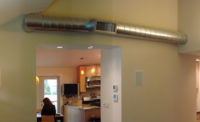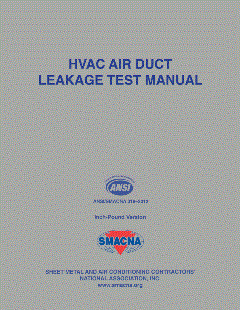As the U.S. Department of Energy (DOE) continues to implement energy conservation standards that affect numerous HVACR appliances and components, industry leaders are pointing out that high-efficiency heating and cooling equipment is only as good as the ductwork it’s attached to. That’s why they’re seeking to define what, exactly, green ductwork is and determine how it can be implemented in homes and buildings throughout the U.S.
WHAT MAKES DUCTWORK GREEN?
The recipe for green ductwork is part performance, part materials, and part cost. A solid first step in ensuring ductwork is green is by sealing any leak.
According to the DOE, the average U.S. home’s ductwork leaks 20-40 percent, and commercial ductwork in the U.S. leaks an average of 10-25 percent, said Neal Walsh, senior vice president of strategy and commercial sales for Aeroseal LLC. “From an energy perspective, it’s probably one of the biggest energy wasters in both homes and commercial buildings.”
Reducing duct leakage not only saves energy, but it also reduces emissions, said Eugene Smithart, professional engineer and director of systems and solutions at Trane, a brand of Ingersoll Rand. “Whenever you’re talking about lower energy consumptions, you’re talking about reducing our industry’s most important greenhouse gas [GHG] emission — utility-generated GHG emmisions.”
Sealing ducts using mastic sealant helps reduce duct leakage from the outside; meanwhile, in areas where the ductwork can’t be reached, aerosol sealants such as Aeroseal eliminate leaks in the ductwork from the inside out.
“In spite of the meticulous prep and the craftsmanship that goes into designing ductwork and trying to seal it, the fact remains that the majority of ducts aren’t tight enough after they’ve been installed, and it’s a huge source of energy loss,” Walsh said. “Aeroseal has the ability to ensure air ducts are incredibly tight and do it in the most cost-effective way possible — not only for new ductwork, but for existing ductwork, too. The ability to go back and make those ducts green with conventional methods is very difficult because of space constraints. We can create green ducts.”
ROUND RULES THE ROOST
The type of ductwork also plays a large part in whether it can be considered green. According to Smithart, spiral ductwork is inherently superior to rectangular ductwork in terms of energy efficiency, leakage, and installation and material costs. When sized and installed correctly, it’s very green.
“We can significantly reduce the installed cost compared to what’s traditionally been used and is still used in a large percentage of VAV [variable air volume] systems, which is rectangular ductwork,” Smithart said. “In going to a higher velocity — static regain — you can frequently reduce the installed cost. At a bare minimum, you’re somewhere in the range of a $100- to $400-per-ton reduction in install costs. But, environmentally, it’s also green because you’re typically using less material.
“Rectangular ductwork, in general, goes in for about a half a pound of material per square foot, whereas round goes in for about a quarter of a pound per square foot,” he continued. “And, this is at equal or lower fan total static pressure, even though round ductwork is normally utilizing a higher velocity. Its fittings are more efficient, and fittings represent a significant percentage of the friction loss.”
Round ducts also last longer and leak less, said John Reints, professional engineer and design and build contractor. “It’ll last twice as long, maybe 40 years compared to 20 years. Rectangular also typically has 200 percent or more seams than spiral, and it’s the seams that leak.”
“A decade ago, the leakage rate of rectangular ductwork was at least 10 percent or higher,” Smithart added. “Today, with the best technologies in rectangular duct, you may be able to get that down to 3 percent when the job is first started. But, round duct can be easily installed to meet a 1 percent leakage rate — or less than half a percent leakage rate.”
BUILDING AWARENESS
Unfortunately, many building owners don’t think about checking the ductwork, let alone sealing and testing it, Reints said.
“In a big building, let’s say you have a $500,000 chiller. Most people focus on the chiller and try to buy that for a better price, but there’s also $500,000 worth of ductwork, and nobody ever looks at it,” he said. “It’s the next frontier in terms of energy savings — to see how to make the ductwork work better.”
“How much more money would you pay to get a chiller that was 30 percent more efficient, or even 6 percent more efficient? The answer is, a lot,” Smithart added.
One way to bring duct issues to light is to involve the customer in the diagnosis.
“Make homeowners detect it in their own homes,” said David Richardson, curriculum developer and trainer at the National Comfort Institute (NCI). “By including them in testing their own home, it allows them to be more involved and interested — that’s a big learning experience, right there.”
Not only is duct renovation — the process of making ducts greener — beneficial in terms of energy savings, it can also be a boost to the contractor’s bottom line. But, in order to ensure the ducts are as green as possible, the contractor must test and verify the duct system’s performance.
“Test it — that’s where the rubber meets the road,” Richardson said. “Prove your systems outperform the competitions by testing and showing proven results.”
Publication date: 9/21/2015
Want more HVAC industry news and information? Join The NEWS on Facebook, Twitter, and LinkedIn today!









